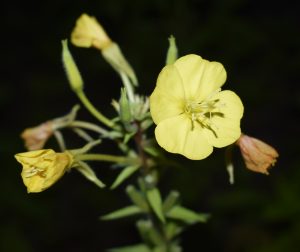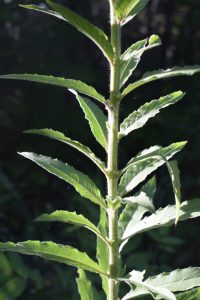Common Evening Primrose
 Oenothera biennis flowers appear limp and faded during daylight hours — as I discovered after several fruitless visits! At first, I thought it was my own bad timing that I kept missing petals in their fully open stage. What was going on here?! Then, thinking perhaps there was a reason the common name of this striking plant has ‘evening’ in it, I decided to change tactics. In so doing, I learned that what I was finding in the light of day was merely the leftover, faded blossoms from the previous night’s revelries. Evening primrose really does live up to its name!
Oenothera biennis flowers appear limp and faded during daylight hours — as I discovered after several fruitless visits! At first, I thought it was my own bad timing that I kept missing petals in their fully open stage. What was going on here?! Then, thinking perhaps there was a reason the common name of this striking plant has ‘evening’ in it, I decided to change tactics. In so doing, I learned that what I was finding in the light of day was merely the leftover, faded blossoms from the previous night’s revelries. Evening primrose really does live up to its name!
Flowers appear from July into October on this native, biennial plant. After the basal rosette growth of the 1st year, in the 2nd year the plant sends up a floral spike developing blossoms towards the top of the stem that begin to bloom from the bottom up a few at a time, the yellow flowers turning orange as the petals fade.
Many varieties of bees, butterflies and other insects make their way inside the drooping petals during the day. Hummingbirds will sneak in some sips at that time as well. Nighttime, however, is when evening primrose truly shines. As darkness falls completely, the petals that have hung closed and uninterested for the last 12 hours begin to open up so that at about 9:00 PM the lovely blossoms are firm and wide open to the sky, catching the light of moon and stars, releasing their alluring, fragrant scent into the night, and sending out their many invitations to come on in for some sweet nectar and pollination. In response, nighttime moths and even bats arrive fresh and ready to party.


Besides being a host plant for several moth species, including a special group of parasitic moths, several beetle species feed on the leaves as well. The seeds inside the woody seed capsules of evening primrose are high in GLA fatty acids and can linger on the plant into the winter providing food for pine siskins, goldfinches, and other songbirds. The oil offers health benefits to humans as well for a wide variety of conditions from skin lotion, to hormonal and inflammation support.
It certainly takes all kinds to make up a world, and that includes these fascinating flowers that have evolved to possess night owl tendencies, offering a wide spectrum of usage for so many species of earth’s creatures!
